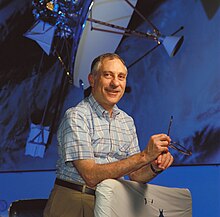James B. Pollack
James B. Pollack (born July 9, 1938 in New York City , † June 13, 1994 ) was an American astrophysicist and planetologist.
Pollack grew up in Woodmere, Long Island . He studied physics at Princeton University with a bachelor's degree in 1960 and at the University of California, Berkeley , with a master's degree in 1962. He received his doctorate in 1965 with Carl Sagan at Harvard University . From 1970 he worked at the Ames Research Center of NASA . He died of a rare form of cancer.
He dealt especially with the atmospheres of Mars and Venus, where he evaluated the data of the Mariner 9 and Viking probes at Mars and then developed computer simulations of the weather on Mars (with Robert Haberle). With James F. Kasting he developed models for the history of the climate in interaction with the crustal development on Mars and Venus. In 1996 he and colleagues developed a model of the formation of the large gas planets. He worked with Carl Sagan on topics such as Nuclear Winter , which arose from his research into the atmospheric effects of the asteroid impact on the Cretaceous-Tertiary boundary (with Chris McKay, Brian Toon, and others). He also explored the possibilities of terraforming Mars. Later he worked on supercomputer simulations of the formation of planetary systems (with Pat Cassen, Robert Cabot and others). He also made early studies of the influence of volcanoes on the climate, for example in 1981 on the occasion of the Mount St. Helen eruption .
At the Ames Research Center he also planned missions from space probes and evaluated the data from the Kuiper Airborne Observatory, for example on the cloud composition of Venus, the surface structure of Mars and its dust clouds or the size of the dust particles in the rings of Saturn. He also played an important role in almost all of NASA's planetary missions (Mariner 9, Viking, Voyager, Pioneer Venus, Mars Observer, Galileo). Among other things, he was able to clarify a riddle of the rings of Saturn, why they did not emit radio waves themselves, but were powerful radar reflectors (according to Pollack, the result of the presence of ice particles in the centimeter to meter range).
In 1985 he received the Leo Szilard Lectureship Award and in 1989 the Gerard P. Kuiper Prize . He received the Arthur S. Flemming Award and several NASA medals for Exceptional Scientific Achievement, the Space Science Award from the American Institute of Aeronautics and Astronautics , won the H. Julian Award from the Ames Center, and was an Ames Fellow. He was a Fellow of the American Geophysical Union , the American Association for the Advancement of Science , and the American Astronautical Society .
One of his hobbies was opera.
Fonts
- with JF Kasting, OB Toon: How climate evolved on the terrestrial planets, Scientific American, February 1988
Web links
Individual evidence
- ↑ Pollack, P. Bodenheimer, Y. Greenzweig a. a .: Formation of the Giant Planets by Concurrent Accretion of Solids and Gas, Icarus, Volume 124, 1996, pp. 62-85, bibcode : 1996Icar..124 ... 62P
- ^ RP Turco, OB Toon, TP Ackerman, JB Pollack, C. Sagan: Nuclear winter: global consequences of multple nuclear explosions, Science, Volume 222, 1983, pp. 1283-1292, PMID 17773320
- ^ RP Turco, OB Toon, TP Ackerman, JB Pollack, C. Sagan: On a nuclear winter, Science, Volume 227, 1985, pp. 358-362.
- ^ RP Turco, OB Toon, TP Ackerman, JB Pollack, C. Sagan: Climate and smoke: an appraisal of nuclear winter, Science, Volume 247, 1990, pp. 166-176.
- ↑ JB Pollack, OB Toon, TP Ackerman, CP McKay, RP Turco: Environmental effects of an impact-generated dust cloud: implications for the cretaceous-tertiary extinctions, Science, Volume 219, 1983, pp. 287-289, PMID 17798276
| personal data | |
|---|---|
| SURNAME | Pollack, James B. |
| BRIEF DESCRIPTION | American astrophysicist and planetologist |
| DATE OF BIRTH | July 9, 1938 |
| PLACE OF BIRTH | New York City |
| DATE OF DEATH | June 13, 1994 |
